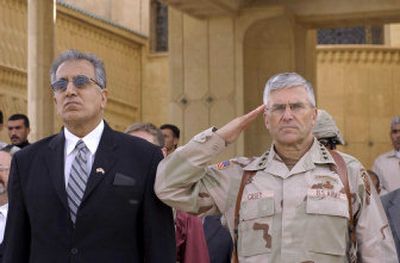Widespread looting followed turnover of palaces to Iraqis

BAGHDAD, Iraq – On Nov. 22, the top U.S. military and civilian leaders in Iraq handed over Saddam Hussein’s most lavish palace compound to the safekeeping and control of the new Iraqi army and government, in a ceremony whose intended symbolism was as impossible to ignore as the military brass band.
“The passing of this facility is a simple ceremony that vividly demonstrates the continuing progress being made by the Iraqi government and their people,” said Col. Mark McKnight, commander of 1st Brigade Combat Team, 3rd Infantry Division, who handed the keys to the palaces to the governor of Salahuddin province.
But in the days after American forces and the Iraqi brass band pulled out of the circular palace drive on a bluff overlooking the Tigris River in Tikrit, local officials now say, looters moved in, ripping out doors, air conditioners, ceiling fans and light-switch plates from some of the compound’s 136 palaces, leaving little more than plaster and dangling electric wires.
The culprits are some of the same Iraqi security forces and officials to whom Americans transferred control, police and the governor say.
“Thank God we were able to save the walls from the looters, because everything else was stolen,” Gov. Hamed Hamood Shekti said by telephone.
Shekti, like police officials, blamed Iraqi soldiers at the palaces and his own deputy. “The palace was turned over to the Iraqi army units in the presence of Deputy Governor Abdullah Naji Jabara,” he said. “Two weeks later I heard the place was looted. Now who can I accuse of the looting?”
Iraqi army commanders in and around Tikrit could not be reached by telephone for comment. Local authorities said Jabara had left on a pilgrimage to Mecca and could not be reached either.
The full extent of the alleged looting could not be determined. A provincial police commander, Lt. Col. Mahmud Hiazza, said soldiers and officials stripped at least some palaces that had been occupied by U.S. officials. “Also, there were some palaces not occupied by Americans,” he said. “Even in those palaces, everything was gone.”
A trip to one of the palaces appeared to substantiate the allegations. A witness, visiting one palace now used by Iraqi police, found officers working in offices stripped of their baseboards and doors, with holes where some air conditioners had sat and plaited wiring in place of electrical switches.
According to local officials, the Iraqi troops responsible for the alleged pillaging came from elsewhere, including the northern city of Mosul.
Over several days after the transfer of control from U.S. to Iraqi hands, furnishings from the palaces turned up in one local market for sale by the truckload, said a Tikrit resident, Rashid Juburi.
U.S. military spokesmen, some expressing surprise, said this month that they had not known of the alleged looting spree after the handover. They stressed that the Tikriti palaces, after Baghdad’s Green Zone the most prominent U.S. installations eventually slated for return to Iraqi authority, were no longer U.S. troops’ concern.
A succession of U.S. military units used the palaces as a base after U.S. troops entered Iraq in March 2003. The 1,000-acre compound includes some of the most impressive scenery in Iraq, with sweeping views of the Tigris River valley. Saddam was born in a village outside Tikrit.
Gen. George Casey, commander of U.S. forces in Iraq, and U.S. Ambassador Zalmay Khalilzad were among the dignitaries who choppered out to Tikrit for the handover ceremony in November.
Shekti, the governor, said in his remarks that day that the handover highlighted “many national aspirations and goals. The first aspiration is the day when all multinational forces will be able to leave Iraq. The second aspiration is convincing the court of world opinion that the people of Iraq are able to manage their affairs independently.”
In Washington, the Bush administration trumpeted the handover. “The Iraqi forces are becoming more capable on a daily basis, and so this was, I think, an important example of that process moving forward,” State Department spokesman Sean McCormack said that day. “It was, I think, symbolically important that this was a handover of one of Saddam’s former palaces that he built in his hometown, and now Iraqi forces that truly represent the will of the Iraqi people are now going to have control of that palace.”